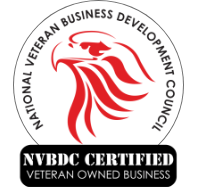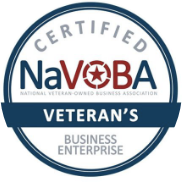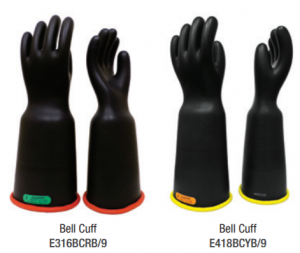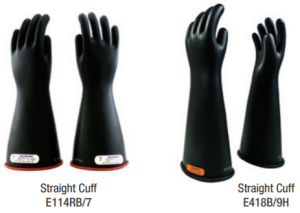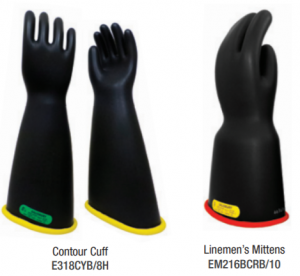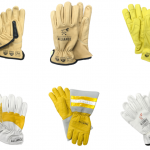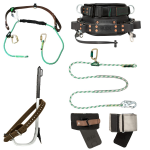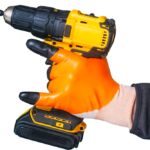High Voltage Electrical Gloves – How to Clean and Inspect Them
Linemen do a lot of work with their hands on electrical equipment. This makes it important for linemen to use the proper electrical insulated gloves to protect themselves from possible electric shocks and arc flashes. Electrical gloves are personal protective equipment (PPE) required by OSHA in high-voltage and low-voltage applications for those working on or near energized circuits. These gloves are also the first line of defense to protect linemen from contact with energized circuits and power lines.
Electrical insulated gloves should be used along with other PPE by all linemen as they work on or near energized equipment. Even if workers are not directly touching electrical circuits, arc flashes and arc blasts from the electrical circuit can still cause injury. Linemen must protect themselves by using electrical gloves that are appropriate for the voltage levels of the equipment they are working on. It is important for linemen and other utility workers to understand which insulating gloves are best for specific applications and know how to clean and inspect their gloves.
In this guide, we will explain what electrical insulated gloves are, including the classes of gloves, and discuss how to properly clean and inspect your gloves to ensure they will provide the proper protection. At Divergent Alliance, we can provide electrical gloves for linemen and utility workers from Salisbury by Honeywell with fast shipping in the Chicago, IL area and across the U.S.
Call Divergent Alliance at (847) 531-0559 or submit a contact form to get our volume pricing for electrical insulated gloves.
What are Electrical Insulating Gloves?
Electrical insulating gloves are rubber gloves that provide protection against voltage and electric shock. These gloves are worn under leather protectors that prevent punctures, cuts, and abrasions to the rubber. Rules and regulations for the manufacture, testing, and classification of electrical insulating gloves can be found in OSHA 29 Code of Federal Regulations (CFR) 1910.137.
Electrical Glove Classification
According to OSHA standards, workers must use electrical insulated gloves when making contact with hazards above 50 volts AC. Both low-voltage and high-voltage electrical gloves are categorized into six different classes depending on the level of voltage protection they provide. These gloves are also categorized into Type I (not resistant to ozone) and Type II (resistant to ozone).
The following are the classes of electrical gloves:
- Class 00: Maximum use AC voltage of 500 volts
- Class 0: Maximum use AC voltage of 1,000 volts
- Class 1: Maximum use AC voltage of 7,500 volts
- Class 2: Maximum use AC voltage of 17,000 volts
- Class 3: Maximum use AC voltage of 26,500 volts
- Class 4: Maximum use AC voltage of 36,000 volts
In most applications, leather protectors should be worn over all classes of electrical gloves to protect the rubber. However, OSHA does allow some exceptions to this. Class 00 and Class 0 gloves do not need to be used with leather protectors if the voltage does not exceed 250 volts AC, or 375 volts DC under limited-use conditions in which higher than normal finger dexterity is needed for small equipment and parts manipulation. Other classes of gloves can also be used without leather protectors, under limited-use conditions when higher finger dexterity is needed for small equipment and parts manipulation, but the employer must also demonstrate that there is only a small possibility of physical damage to the gloves.
Electrical Glove Testing
All electrical gloves must be tested by the manufacturer before they are put into service, and they must be tested every six months after they are put into use. The gloves should also be tested after repair, after use without protectors, and if there is a defect or suspect insulating value.
When new electrical gloves are tested by the manufacturer, a date stamp is put on the gloves to indicate the day that they were initially tested. The pair of gloves must then be put into service in less than 12 months after the initial testing date. If a pair of gloves is not put into service for the first time before 12 months pass from the initial testing date, they will need to be tested again before use. It is best to send electrical gloves to accredited test laboratories for testing.
Electrical Glove Inspection
Rubber electrical gloves are vulnerable to cuts, abrasions, and punctures that can put linemen at risk. Electrical currents can get to the hand if there is even a small puncture in the glove. Because of this, OSHA requires electrical insulating gloves to be inspected carefully for damage, swelling, and defects before each use.
Follow these steps to inspect your electrical gloves according to ASTM standards:
- Start by rolling the rubber of the base of the gloves between your hands. Check both the outside and inside of the glove for any possible damage or defects.
- If you notice something suspicious when rolling the rubber gloves between your hands, you should do a closer inspection of the area by pinching and rolling the gloves between your fingers.
- Check the base and tips of the fingers and thumb. Pull each finger apart and look for damage or irregularities between the fingers.
- After the visual inspection, you must do an inflation test to check for air leaks. Inflations tests can be done manually or with a glove inflator. To do a manual test, roll the bottom of the glove up about 1½ inches so that there is air in the palm and fingers of the glove. Then hold the glove up to your ear and squeeze it so you can listen and feel for any air leaks.
- To use the glove inflator, slide the base of the glove over the inflator and slide the rubber O-ring over the glove to hold it in place. Inflate the glove but be sure not to overinflate it. Type I gloves that are not resistant to ozone should never be inflated more than twice their normal size and Type II gloves that are resistant to ozone should never be inflated more than 1¼ times its size. Hold the inflated glove to your ear and listen and feel for air leaks. Portable glove inflators allow you to inspect the entire glove while manual inflation tests only test the palm and fingers.
If you notice an air leak, the glove must be immediately taken out of service, destroyed, and thrown away. Gloves that have swelling which is usually a sign of chemical contamination should be taken out of service to be cleaned and retested.
Electrical Glove Cleaning
The best way to help maintain your electrical gloves and maximize their lifespan is to properly clean and store them. Make sure you follow these steps for proper cleaning and storage:
- Before cleaning your electrical gloves, inspect them for damage using the steps in the section above.
- Remove jewelry and other sharp objects from your hand and arms that could potentially damage the gloves.
- Use warm water and a mild detergent to clean the gloves and rinse thoroughly. Only soapy water or denatured alcohol should be used to clean the area with the label.
- Electrical gloves should either be air dried or dried manually with a clean, soft cloth.
- To store a pair of electrical gloves, put the gloves on top of each other and into a glove bag specifically designed for electrical gloves. Make sure there are no bends, creases, or folds in the gloves as they must be stored in their natural shape.
- Store the bag with your gloves in a cool, dry place that is free of chemicals, oils, ozone, vapors and fumes, and solvents and keep them away from sharp or heavy objects, sunlight, or possible electrical discharge.
Electrical Insulating Gloves from Divergent Alliance
Electrical insulating gloves are important PPE and the first line of defense for linemen against electrical shock, arc flashes, and arc blasts. Linemen and other utility workers who work on energized equipment must understand how to choose the proper gloves for the job, how to check for damage and defects, and how to properly clean and store them so they can get maximum protection and the longest possible life from their gloves.
At Divergent Alliance, we supply electrical insulated gloves in the Chicago, IL area and across the U.S. The electrical gloves we offer are from the trusted manufacturer Salisbury by Honeywell who offers a wide variety of low-voltage and high-voltage electrical gloves for a range of applications.
You can call Divergent Alliance at (847) 531-0559 or submit a contact form for pricing information. We can provide fast shipping of our products to anywhere in the U.S.


